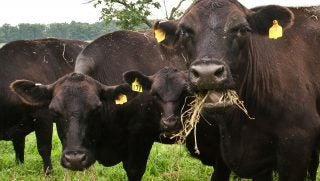Box office receipts don’t lie — the “outbreak” genre sells gobs of tickets. In “Rise of the Planet of the Apes,” a virulent strain of the fictional simian flu decimated the human population. With society in shambles, anti-ape sentiment is poised to fuel a final battle royale against the knuckle draggers. In “Daybreakers,” a plague turned 95 percent of humanity into vampires, a delightful variation of a theme where humans are the minority, hunted, and harvested. In true Hollywood fashion, the flick ends in a predictable over the top bloodbath.
Despite the fact that humans are as prosperous as ever, we’re strangely drawn to gloom and doom. It seems that Hollywood is rife with (almost obligatory) examples. But how much of that on-screen formula is grounded in reality, and how much is fanciful writing?
Well, science fiction is often grounded in science fact. Is simian flu (of Hollywood repute) really that different from avian or swine flu? What are the conditions that might prompt a plague of epidemic proportions? Or at least raise some eyebrows at the CDC?
Consider how many humans and animals are interacting in close quarters. For some context, we have to look no further than the AIDS epidemic of the early 1980s. HIV’s (Human Immunodeficiency Virus’) “patient zero” was very likely someone who consumed bushmeat or otherwise came in contact with a primate infected with SIV (Simian Immunodeficiency Virus). The virus, ever the opportunist, mutated and made the leap from animal to human. In sciencey parlance, these are zoonotic diseases — literally a zoo jailbreak followed by squatting in a new residence (host).
Then there’s the infamous Mad Cow disease — just a rogue misfolded protein that has a singular purpose — to refold other proteins in its own image. Most of us can recall the panic that ensued when reports from the UK surfaced. Another couple of dread-inducing diseases include SARS and Ebola — a veritable rogue’s gallery, all of animal origin.

Bacterial virulence is often attributed to “bonus” rings of DNA called plasmids. Since bacteria are more debauched than the Delta Tau Chi’s of “Animal House” fame, plasmids are exchanged freely. This is the difference between harmless E. coli in your large intestine, and E. coli 0157:H7, a confirmed killer. Not only do plasmids weaponize formerly benign strains of bacteria, but they also potentially reduce the effectiveness of important medical antibiotics.
These are troubling revelations, especially in an environment ever attuned to threats of epidemics and food safety. Last year, I invited a friend of mine from the Virginia Department of Environmental Quality to give a talk at my college. Not coincidentally, he’s also a USDA content expert in zoonotic diseases and agroterrorism. He briefly introduced a concept that was foreign to me — but made intuitive sense — One Health. Usually treated as separate fields, One Health is a concept that merges human and animal health in a unifying framework that’s mindful of both. An exchange of ideas between the lab-coat stiffs!
But there’s one party that’s routinely left out the equation. What about plants? Granted, plant pathogens don’t tend to make such monumental leaps to infect humans. But it doesn’t have be about leaps to be a public health menace. It’s about identifying risk points along a common continuum with three lanes of interweaving traffic — plants, animals, and humans — and jointly devising strategies to manage that risk. Best practices and preparedness.
Animal manure that’s improperly cured can harbor human pathogens. If spread in a field, plants can act as a reservoir. Conventional wisdom has held that the internal tissue of plants, particularly fruits, is clean. No harm in a surface rinse though. Turns out that plants can internalize pathogens from the external environment to a degree. So much for dogma. Plant health professionals also prevent and manage insect injury that would otherwise open doors for fungal contamination of animal and human foodstocks alike.
As a rule, professional practitioners tend to “silo” themselves. This territorial mindset is not going to jive in the 21st century. By all accounts, the fate of humans, animals, and plants are all inexorably linked. As a plant doctor, I think it’s only prudent to see our delegation at the table as partners in a broader One Health trinity.
Tim Durham’s family operates Deer Run Farm — a truck (vegetable) farm on Long Island, New York. As an agvocate, he counters heated rhetoric with sensible facts. Tim has a degree in plant medicine and is an Assistant Professor at Ferrum College in Virginia.



